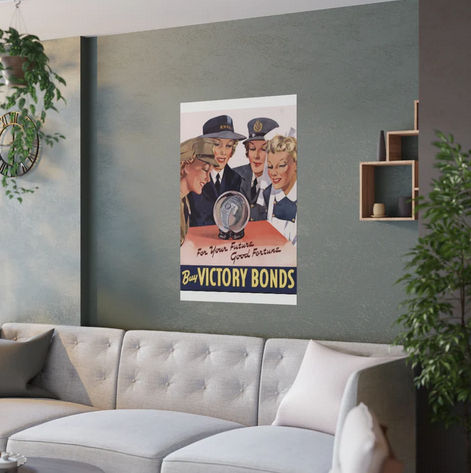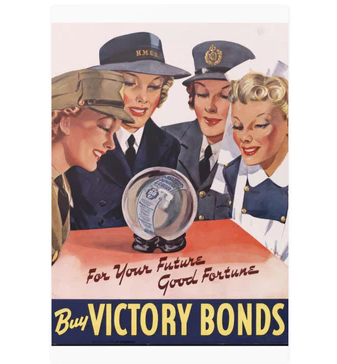Total War
Canadian involvement in the Second World War (1939-45) is defined as “total war”. All available resources – both human and material – were channeled into the war effort. This resulted in drastic changes to the daily lives of numerous Canadian women. While they were barred from serving in active combat roles, Canadian women contributed in myriad ways. Their wartime occupations outside the home included: factory work, nursing, teaching, volunteering, farm labour, clerical duties, enlistment in women’s branches of the armed forces, and more. This was in addition to their domestic responsibilities. As increasing numbers of men went overseas, women on the “home front” stepped up to do necessary work and fill in the gaps.
However, it is important to understand that not all women experienced the war years in the same way. While her gender was always a factor, a woman’s race, ethnicity, religion, geographic location, or economic status also influenced her reception in the public realm. For example, the efforts of Indigenous women were limited by the effects of institutional racism. Women of Japanese descent were classified as “enemy aliens”, and those on the west coast were forcibly relocated further east and monitored. The Canadian female experience of war is not a single narrative, but instead, thousands of individual stories in which common patterns can be found.
Entering the labour market
The most evident change for women during the war was the opportunity for paid employment outside the home. In 1939, 600,000 Canadian women worked outside the home. By 1944, this number doubled to 1.2 million. In a society that still believed that women most often belonged in domestic spheres, this was an unprecedented event. In May 1942, the Department of National Selective Service even created a Women’s Division to place women in sectors most needing workers. The demands of the war were stronger than societal norms.
The booming war economy required additional workers to fill an ever-growing labour shortage. Women across the country stepped into roles that were considered appropriate for their gender, including as secretaries, clerks, nurses, caretakers, fruit packers, and teachers. While women had long been in these types of roles, the sheer number of women entering waged labour outside of the home drastically grew.
However, wartime circumstances also allowed them to enter roles that were traditionally considered masculine. Women capably took paid work in factories, shipyards, and on farms. This disruption in Canadian gender norms was significantly concerning for some. An overall fear that women may lose their “feminine qualities and priorities” through untraditional work was not uncommon. Women working in factories or shipyards were strongly encouraged to maintain their femininity. These messages were conveyed through lectures, magazine articles, and the opening of salons nearby their place of work. Making an effort to remain “attractive” was a patriotic act on equal footing to the work they had taken on.
Perhaps the most striking development was the entry of women into the armed forces. All three services (army, navy, air force) created their own women’s divisions. These divisions were distinct from women who served as nurses—the single military role that had been available to women in all previous conflicts that saw Canadian involvement. These were strictly non-combat roles with women working as cooks, secretaries, mechanics, map readers, drivers, and so on. The majority of these enlisted women served in Canada, but some did make their way overseas.
Unpaid work
While women’s paid employment was a vital part of Canada’s war effort, women’s unpaid labour was their overall largest contribution. Women volunteered in a wide variety of ways, often in addition to their paid labour or household duties. For women, “doing your part” often meant taking on a number of responsibilities.
A common task was preparing items for shipment overseas, such as knitting socks for Canadian soldiers or blankets for British civilians. They hosted dances and events to fundraise for a variety of charities and federal war financing drives. Women demonstrated impressive feats of organization through acts such as running recreational centres to provide entertainment for soldiers stationed in Canada. They learned basic First Aid and trades skills on their own time. There is no doubt that this unpaid (and often overlooked) labour deserves its fair share of credit for carrying the Allies to victory.
The absence of men changed women’s domestic responsibilities as well. Previously, men had been the head of the house; the one to look after property upkeep and family finances. These tasks now fell upon women, who became sole managers of their family. From chopping wood to making budgeting decisions, women’s unpaid labour within the home was no less vital to maintaining Canadian society in wartime. Perhaps most significantly of all, countless women were left to raise (and discipline) children alone—often while taking on those above-mentioned additional wartime responsibilities. As ever, there were general fears that this would result in the overall delinquency of the next generation of youth.
The story of Mary Elizabeth White
A young woman growing up in the Second World War
All of these new opportunities and responsibilities for women make it seem that the Second World War was a watershed moment for gender equality. However, this is a common misconception in popular memory. The post-war years saw a dramatic reversal to the nuclear family dynamic. The majority of women were pushed out of the workforce to make room for returning male veterans—a return to the domestic sphere and traditional gender norms.
Another issue with how we may collectively remember women in wartime is that these perceptions are shaped on a predominantly a white, middle-class, and Anglophone narrative. Not all Canadian women had access to equal opportunities, many were excluded based on their race, ethnicity, religion, geographic location, or economic status. Canadian diversity means that a single narrative of the war does not exist. Instead, we must take a closer look to identify the similarities and divergences.
Support the project:
How can you support the project:
Buy a map today!
We sell many authentic posters from the Second World War.These are high resolution scans of original posters that you can only find in the archives.
Each poster is printed on high quality paper ready for mounting in a frame for your office or living room.
The best part of buying a poster? 100% of proceeds are directed back to the project allowing us to continue to map out the Second World War.



Other ways to support the project:
Donate
You can help us tell the story of Canadian soldiers by donating today!
Our team is dedicated to keeping the story of Canada in the Second World War at the forefront using interactive technology that makes history open and accessible.
With your donation you help us to keep mapping and digitizing war diaries so we can continue to tell the story of those who served and those who fell.
Join Patreon
Do you want to become part of the team? Consider joining Patreon!
As a member of Patreon you can influence our project, what we are working on, and can even direct message our team. As a Patreon you can even get discounts to our entire store!
With your membership you can show your commitment to the project by helping us every month. And the best part is, every Patreon dollar goes directly to the web map!


![Women shipyard workers 'bolt up' a ship [at Pictou shipyard, Pictou, NS].](https://images.squarespace-cdn.com/content/v1/5b855caf3e2d09b204e7cad5/1666885635884-1ZU7Y3O5RBOVB0JLRBBZ/1.jpg)



















